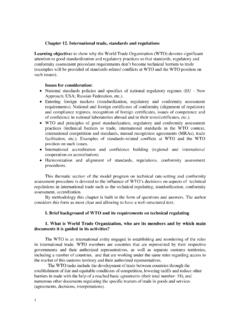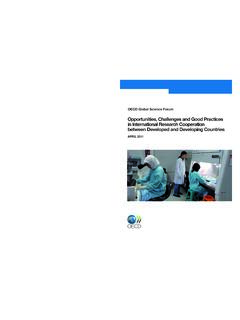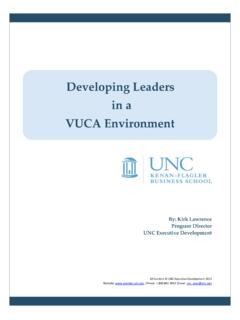Transcription of 7 Singapore: Rapid Improvement Followed by Strong ... - OECD
1 7. Singapore: < Strong >RapidStrong > < Strong >ImprovementStrong > < Strong >FollowedStrong > by Strong Performance Singapore is one of Asia's great success stories, transforming itself from a developing country to a modern industrial economy in one generation. During the last decade, Singapore's education system has remained consistently at or near the top of most major world education ranking systems. This chapter examines how this tiny red dot on the map has achieved and sustained so much, so quickly. From Singapore's beginning, education has been seen as central to building both the economy and the nation. The objective was to serve as the engine of human capital to drive economic growth. The ability of the government to successfully match supply with demand of education and skills is a major source of Singapore's competitive advantage.
2 Other elements in its success include a clear vision and belief in the centrality of education for students and the nation; persistent political leadership and alignment between policy and practice; a focus on building teacher and leadership capacity to deliver reforms at the school level; ambitious standards and assessments;. and a culture of continuous < Strong >ImprovementStrong > and future orientation that benchmarks educational practices against the best in the world. Strong Performers and Successful Reformers in Education: Lessons from PISA for the United States OECD 2010 159. 7. Singapore: < Strong >RapidStrong > < Strong >ImprovementStrong > < Strong >FollowedStrong > by Strong Performance Introduction When Singapore became independent in 1965, it was a poor, small (about 700 km2), tropical island with few natural resources, little fresh water, < Strong >RapidStrong > population growth, substandard housing and recurring conflict among the ethnic and religious groups that made up its population.
3 At that time there was no compulsory education and only a small number of high school and college graduates and skilled workers. Today, Singapore is a gleaming global hub of trade , finance and transportation. Its transformation from third world to first in one generation is one of Asia's great success stories (Yew, 2000). All children in Singapore receive a minimum of 10 years of education in one of the country's 360 schools. Singapore's students were among the top in the world in mathematics and science on the Trends in International Math and Science Study (TIMSS) in 1995, 1999, 2003 and 2007. They came fourth in literacy in the 2006 Progress in International Reading Literacy Study (PIRLS). Their excellence is further underlined by the fact that Singapore was one of the top-performing countries in the 2009 PISA survey (Table and Figure ), the first PISA survey in which it participated.
4 Singapore was rated as one of the best performing education systems in a 2007 McKinsey study of teachers (Barber and Mourshed, 2007), and was rated first in the 2007 IMD World Competitiveness Yearbook (IMD, 2007) for having an education system that best meets the needs of a competitive economy. At the higher education level, the National University of Singapore was ranked 34th in the world and 4th in Asia in the Times Higher Education Supplement Rankings of World Universities in 2010 (Times Higher Education Supplement, 2010). How has this little red dot on the map, as Singaporeans frequently refer to their country, a nation that is not even 50 years old, evolved from a backwater undeveloped economy into a world economic and educational leader in such a short period of time? What education policies and practices has Singapore employed?
5 And are the lessons from Singapore's experience relevant for other countries ? This chapter attempts to provide some answers to these questions. First, however, we look at the broader context. Table Singapore's mean scores on reading, mathematics and science scales in PISA. PISA 2000 PISA 2003 PISA 2006 PISA 2009. Mean score Mean score Mean score Mean score Reading 526. Mathematics 562. Science 542. Source: OECD (2010), PISA 2009 Volume I, What Students Know and Can Do: Student Performance in Reading, Mathematics and Science, OECD Publishing. 1 2 Under British colonial rule, from 1819 onwards, Singapore developed as a major seaport at the mouth of the Malacca Straits, on the shipping lanes between Britain, India and China. During this period, it attracted large numbers of immigrants, primarily from southern China, India and the Malay Archipelago.
6 At independence from Britain in 1959 and then separation from Malaysia in 1965, Singapore had no assets other than its deepwater port. There was no real economy, no defence, and simmering tensions with neighbouring countries . Moreover, it had to import most of its food, water and energy. The Republic of Singapore seemed an unlikely candidate to become a world-class economic and educational powerhouse. The risks facing this nation at birth the sense of political and economic vulnerability to larger countries and global changes created a sense of urgency which influences policy to this day. Lee Kuan Yew, Singapore's first Prime Minister, set out two overarching goals: to build a modern economy and to create a sense of Singaporean national identity. He recruited the best and brightest people into his early government and sought to promote economic growth and job creation.
7 In the 1960s, the emphasis was on attracting labour-intensive foreign manufacturing to provide jobs for its low-skilled workforce. In the 1970s and 1980s, a shift to more skill-intensive manufacturing led to an emphasis on technical fields. From the mid-1990s on, Singapore has sought to become a player in the global knowledge economy, encouraging more research- and innovation-intensive industry and seeking to attract scientists and scientific companies from around the globe. The results of the government's economic policies have been stunning < Strong >RapidStrong > economic growth to reach developed country levels and a per capita income in 2009 estimated at current market prices to be about SGP 52 000 (USD 39 000). One of the so- called Asian Tigers, Singapore is a free market, business-friendly and globally-oriented economy, shaped by an active and interventionist government.
8 160 OECD 2010 Strong Performers and Successful Reformers in Education: Lessons from PISA for the United States 7. Singapore: < Strong >RapidStrong > < Strong >ImprovementStrong > < Strong >FollowedStrong > by Strong Performance The government of Singapore is a highly efficient, honest and flexible meritocracy with a Strong focus on integrated strategic planning and detailed execution. Dream, Design, Deliver aptly characterises its approach to policy development and implementation. Singapore's small size and political stability (the same People's Action Party has ruled Singapore since Independence) have kept the vision of making Singapore a great global city constant, but have also enabled it to be versatile in responding to rapidly changing environments. With a small limited domestic market, Singapore has had to become highly integrated in the global economy.
9 To survive several global recessions and the ever-present uncertainties of the global economy, continuous innovation has been essential. With respect to Lee Kuan Yew's second goal of nation-building, early race riots led to a profound commitment to creating a multi-racial and multi-ethnic society. At independence, Singapore had multiple religious groups (Buddhist, Muslim, Taoist, Hindu and Christian); multiple ethnic groups (Singapore's population is about 74% Chinese, 13%. Malay, 9% Indian and 3% other); and no common language. Nor did it have a common school system or a common curriculum. A series of measures were gradually put in place to realise the Singapore pledge: One united people regardless of race, language or religion . Singapore recognises and teaches four official languages Chinese, English, Malay and Tamil although English is the language of government and, since 1978, the medium of instruction in Two years of compulsory national service unite different ethnic groups, as does the policy of mixing each group within the government-built housing where most Singaporeans live.
10 This has helped avoid the racial and ethnic segregation that afflicts many countries . Schools play a major role in inculcating Singaporean values and character, and civic and moral education play a major role in schools. Honesty, commitment to excellence, teamwork, discipline, loyalty, humility, national pride and an emphasis on the common good have been instilled throughout government and society. Lacking other resources, human resources were and still are seen as the island republic's most precious asset. Education was seen, from the beginning, as central to building both the economy and the nation. Its job was to deliver the human capital engine for economic growth and to create a sense of Singaporean identity. The economic goals of education have given education policy a very pragmatic bent and a Strong focus on scientific and technical fields.


















